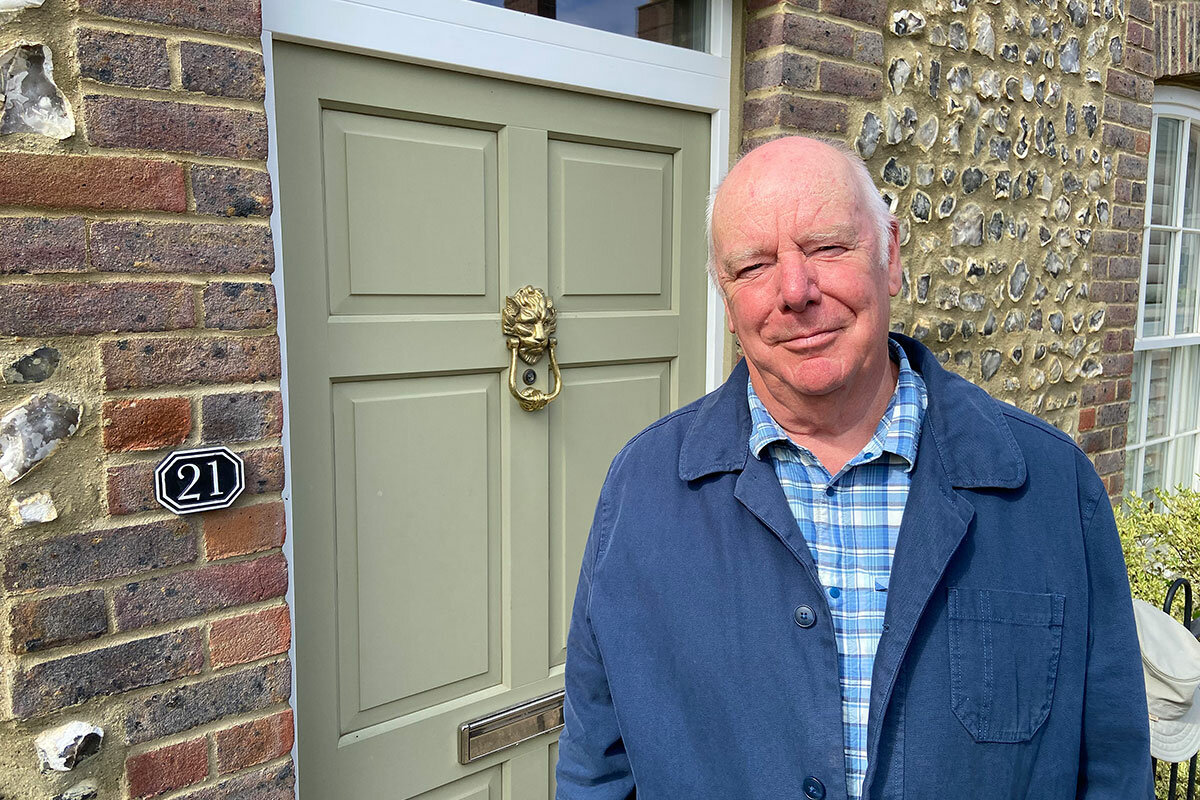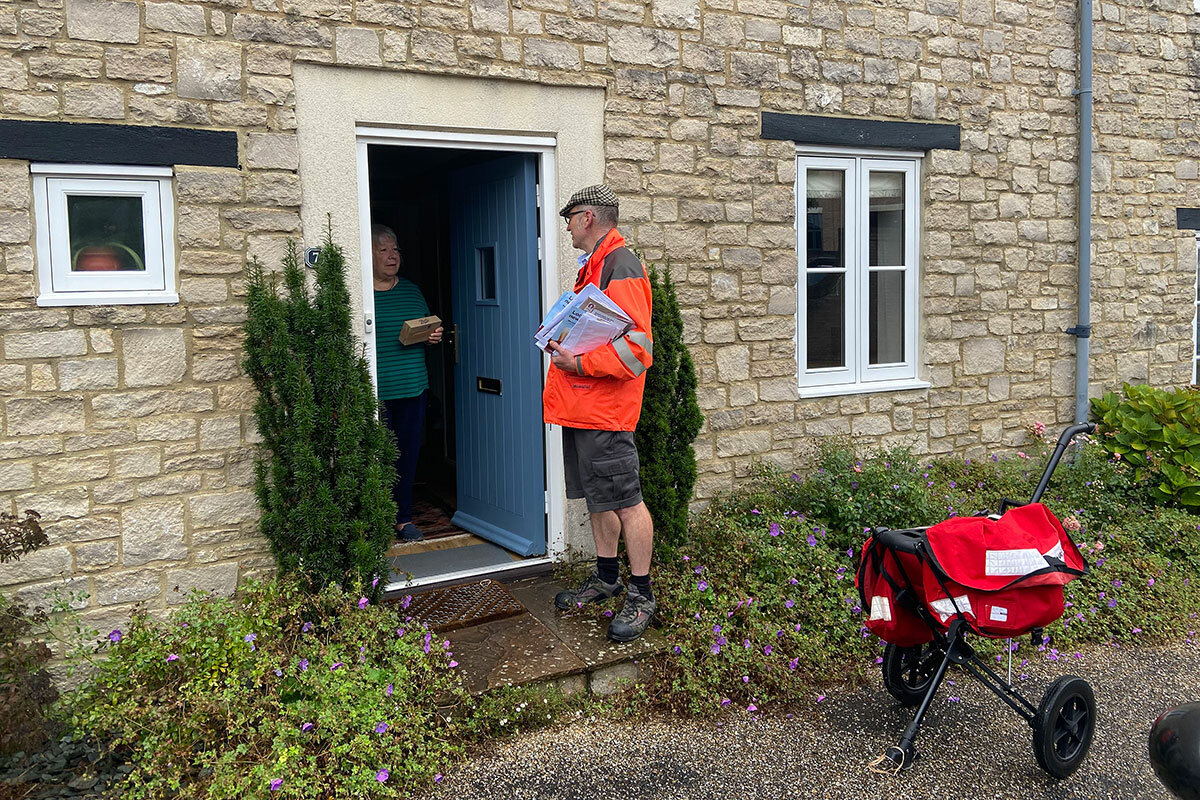Planned English town reveals Charles’ recipe for an ideal future
Loading...
| Poundbury, England
In the days when he was crown prince, King Charles III voiced strong and controversial opinions on many topics. But he reserved his strongest and most controversial remarks for architecture and land use.
He once compared Britain’s postwar urban planners, unfavorably, with the German bombers that had reduced neighborhoods to rubble during World War II. Most famously, he called a proposed modernist extension to London’s National Gallery “a monstrous carbuncle on the face of a much-loved and elegant friend.” (The project was killed.)
But Prince Charles wasn’t just a talker. He was a doer. Here on a sloping green plain in southwest England stands the fruit of his passion: an experimental town that the future king built.
Why We Wrote This
A story focused onThirty years ago, King Charles started building a town that matched his vision of urban planning. Today, though Poundbury’s architecture may be traditional, its sense of community meets modern aspirations.
Founded in the 1990s, Poundbury has grown into a community of around 3,800 residents who live in an eclectic mix of low-rise houses and apartments built mostly to traditional designs, from Georgian townhouses to Italianate squares, though a few modern structures dot the townscape. The streets, few of which run in straight lines, are free of both litter and stop signs. There are no billboards, nor power lines. Ignore the cars and you can easily picture Sherlock Holmes arriving at a foggy crime scene.
It is an ambitious project that expresses the new king’s vision of how Britain should build its way out of a housing shortage, a vision that is deeply personal and not universally shared, given his anti-modernist zeal. “It’s his baby,” says Pru Wintrip, who has lived in Poundbury since 2003.
Now, though, the experimental town belongs to Charles’ son and heir Prince William, who has inherited the Duchy of Cornwall, first established in 1337, and its $1.4 billion portfolio of assets, including the land on which Poundbury is built.
“It’s something everybody has been thinking about for a long time,” says Blake Holt, who chairs the residents’ association. “Our assumption is that William will be just as engaged as his father was, and maybe in a different way.”
Quirky mix and match
The project’s master planner is Leon Krier, a Luxembourg-born architect and theorist of new urbanism, a movement very much in line with Charles’ thinking that abhors auto-centered suburbs and favors walkable towns and cities that blend housing, business, retail, and green space.
In a 2014 essay in The Architectural Review, Charles said his goal was to create “resilient, truly sustainable, and human-scale urban environments that are land-efficient, use low-carbon materials, and do not depend so completely upon the car.” He complained that British towns “have been systematically broken down into zones with shopping and commercial zones sitting separately from the housing zones they serve, many of which look exactly the same.”
Poundbury’s architects have gone out of their way to avoid such repetitiveness. The project mixes and matches architectural designs and house colors and trims, which homeowners are obliged to maintain so as to preserve the town’s appearance.
It’s a quirky sort of place. Neoclassical squares sit next to pseudo-warehouse conversions; back alleys lead to mews houses, a style that originated as horse and carriage stables. Hundreds of small businesses are sprinkled throughout – bike shops and bridal gown seamstresses, clinics and beauty salons, cafes and a funeral home.
The accretion of traditional styles of buildings seems to stretch back centuries, rather than decades, though the builders aren’t so fastidious: Some of what appears to be exterior metalwork is in fact painted fiberglass, for example. Ben Pentreath, one of the main architects, told The Guardian in 2016 that “we are engaged in creating a convincing fake.”
But it has fostered a genuine community, which was one of Charles’ priorities. He has argued that car-oriented, purely functional-built environments lead to social isolation. In Poundbury, civic life thrives, from choirs and drama clubs to playgroups for children and a gardening club. Two community gardens offer plots to residents, the town square, Queen Mother Square, (named for Charles’ grandmother) hosts a food and arts festival in August, and a nondenominational Christian church relocated to the town in 2018.
“There is a strong community here,” says Mr. Holt.
A model for elsewhere?
Around 35% of homes in Poundbury are affordable housing, either sold at below-market prices or rented to low-income families. But these units aren’t clumped together, as they are in most British cities, and it’s not readily apparent which houses on a Poundbury block are social housing.
Still, most homeowners are fairly affluent and include retirees like Mr. Holt, a former human resources executive, who downsized from a large rural property to a three-story townhouse. A two-bedroom house in Poundbury can cost as much as $500,000, and luxury apartments in Queen Mother Square run into the millions.
David West, a sales manager at a real estate agency, says buyers compare Poundbury with other well-kept towns around Dorset, a county that is popular with retirees, and “either love it here or think, ‘It’s not for me,’” he says.
The ones who love it do so for the town’s style, an expression of Charles’ version of town life, says Mr. Holt. “People who choose to buy here … buy into the ethos about building differently [and] building an attractive, amenable community,” he says.
The big question for urban planners is whether such towns offer any kind of model for how Britain should expand its housing stock amid rising concerns about affordability.
Land-use restrictions have driven up housing costs to the point where home ownership is an impossible dream for many young people. In 2004, some 59% of 25-to-34-year-olds owned their own homes. By 2016, that proportion had fallen to 34%, according to a 2019 research paper.
The same study found that high prices reflected a sharp decline in new-home construction, particularly in southern England. Between 1959 and 1988, England built around 7.5 million homes. Over the following 30 years, it added only 3.3 million.
More than a “toytown”
To critics, Poundbury is a prince’s pet project, an anti-modernist statement that is too costly and cumbersome to solve a pressing housing crisis. But Mr. Holt says that misses the point that he has heard Charles make – that Poundbury’s advantage over cookie-cutter subdivisions is that it supports civic life.
“I would argue … that it does not have to be more expensive,” says Mr. Holt. “Not necessarily with all the architectural flourishes and big squares, but to build in a more people-friendly and attractive way,” he says.
Even if it costs “a little bit more,” he adds, “isn’t it worth a little bit more in order to give people a better environment in which to live?”
Clare Rowlands, a health-care worker who grew up in the nearby town of Dorchester, thinks so.
In the early days, she says, locals dismissed Charles’ project as a “toytown” and her father would reminisce about the open fields that it replaced. But in 2012, Ms. Rowlands moved to Poundbury so her son could attend a nearby primary school. She likes her three-bedroom house, though she gripes about the rules that stop her replacing the original wooden windows with plastic frames, and she enjoys living in a walkable town.
When Ms. Wintrip and her husband moved here in 2003, their first house looked onto fields where they could walk their dogs. The couple later moved to a smaller townhouse; their son also bought his own home nearby.
But after two decades of watching Poundbury grow and fulfill Charles’ vision, Ms. Wintrip sounds almost regretful. “It’s too big,” she says. “It’s a town now.”









